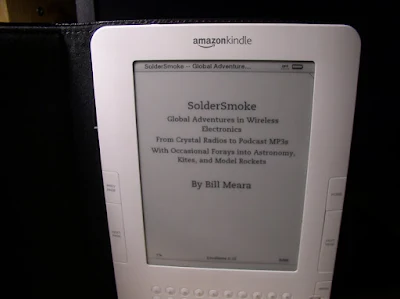
We will discuss this in SolderSmoke Podcast 133, but for those of you who are not among the MORE THAN 200 listeners who went to the recipe site, I thought I should post the REALLY INCREDIBLE e-mail that started all this.
Before you read it, you might want to fire up that Italian-English translation feature in Google and check out the meaning of some of names and places. Like Dr. Andrea BUGIARDO who wrote in the Italian magazine Radio-FURBIZIA while living in the beautiful mountain town of SCERZO-BARZELLETA in the picturesque (I'm sure!) province of TRUCO-IMBROGLIO.
--------------------------------------------
TO: soldersmoke@yahoo.com
FROM:i.nocente@primaprile.it
SUBJECT: CHEMICAL TAILORING OF CRYSTAL MICROPHONE AUDIO RESPONSE
Ciao Bill! Greetings from not-so-sunny Roma! After I read you blog posting (http://soldersmoke.blogspot.com/2011/03/homebrew-literally-your-own-microphone.html) with the video about how to grow your own piezo-electric crystals at home, I was reminded of an article from an old Italian radio magazine that I came across not long ago. Having heard of your recent (well, long-standing) problems with audio quality and microphones, it occurred to me that this old Italian article might be the solution to your audio difficulties.
The article appeared in the Italian radio magazine "Radio-Furbizia" April 1950. Tough times in Italy! Hams had to be inventive and ingenious, and they had to put to work whatever resources they had at hand. Dottore Andrea Bugiardo, I0SOL, was clearly a man for those times. During the post-war period, writing from his hamshack in the beautiful village of Scherzo-Barzelleta, in the province of Truccoimbroglio, OM Bugiardo produced a steady stream of truly incredible ham radio innovations.As you know, life in an Italian home revolves around the kitchen, so it should come as no surprise that Bugiardo based many of his devices on things that he found there.
Bugiardo opens his April 1950 article with a really touching admission of his deep, unfulfilled yearning for a Astatic D-104 microphone. I know this mic was not warmly received by your listeners (insensitive brutes!) but for Bugiardo, the D-104, with its chrome and its art-deco lines was the epitome of ham radio class! As you know, style and good design are important for Italians -- this is the country of "bella figura!" But alas, the dire economic situation did not permit Dr. Bugiardo to buy his coveted chrome lollipop. But, being a true ham, a ham's ham, he decided to "roll his own"as you Americans would say. He decided to build his own D-104.
The exterior did not represent a major problem. He had many friends in Milano who could handle the needed metal and chrome work. The problem was electrical... or should I say electro-mechanical. You see, Bugiardo needed the key component, or perhaps I should say, the key ingredient: he needed the piezoelectric element, the transducer, the piezo-electric device that transforms sound to electricity. It is very interesting. In growing his crystals, Bugiardo employed essentially the same techniques as described in the video on your blog. But -- and here is where I think his article could help you -- he went a significant step further and described how -- by using simple substances found in any kitchen -- the audio characteristics of the microphone can be tailored to the needs of any individual human voice. Bugiardo's research showed that by adding certain common crystalline substances to the standard mix for piezo-electric crystals (the familiar Tartar sauce formula) we can actually come up with the kind of mic we need! No need for EQ or mixer boards! Just start out with the right kind of crystal for your voice, and you are, as you guys say, "good to go!
The physics of this is all based on the physical mechanics of the crystals -- motional inductance and all that. I'll spare you the gory details. Here is the essential information:
-- You start with the standard mix for the crystal element as described in the ARRL Handbooks (this formula appears in all the handbooks from the 40's and 50's).
-- In order to have a mic that accentuates the high notes in the voice, add approximately 5 grams of sugar to the mix.
-- For a stronger bass response, highlighting the low frequencies, add approximately 5 grams of salt. Ordinary table salt will do.
-- For a "punchy" DX-hunter's sound, Bugiardo recommends adding some Tabasco sauce to the Tartar sauce before the initial mixing. (He says this will give you about 3.2456 db gain!)
-- As for your whistling SSSSS problem, Bugiardo's "cook book" does seem to hint at a solution: He says that by adding some molasses to the mixture, you can sort of "smooth out" the response. (This is no doubt caused by the molasses adding its sticky-ness to the crystal matrix.) PLEASE give this a try Bill. Mama Mia! Those whistles hurt my ears!
Anyway, I hope this proves useful. We all really enjoy the podcast.
Ciao,
Carlo
 Jeri Ellsworth's 555 contest is in the home stretch, and I've got my acceptance speech all ready. "I'd like to thank the members of the Academy... and above all the people of the Azores, who were put at risk by the large kite that carried my 555 timer circuit and 35 mm camera over their unprotected heads..."
Jeri Ellsworth's 555 contest is in the home stretch, and I've got my acceptance speech all ready. "I'd like to thank the members of the Academy... and above all the people of the Azores, who were put at risk by the large kite that carried my 555 timer circuit and 35 mm camera over their unprotected heads..."







































